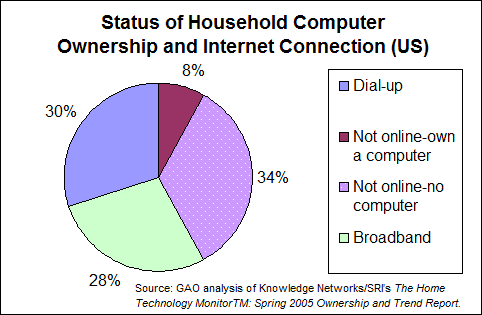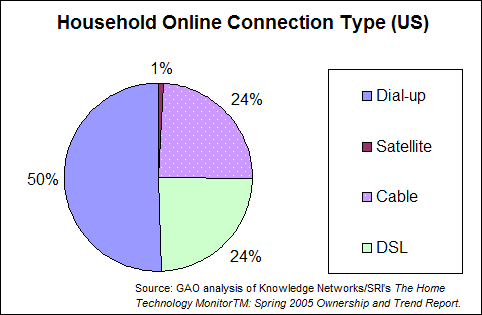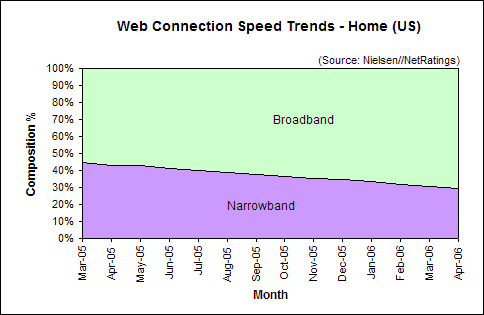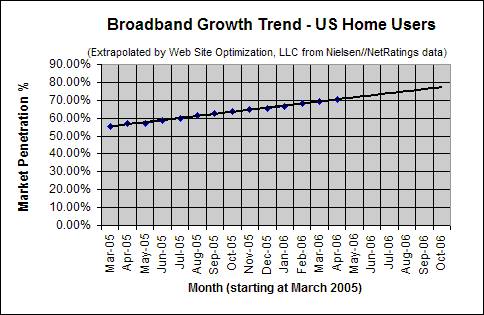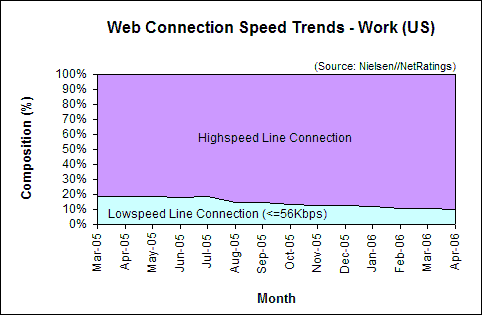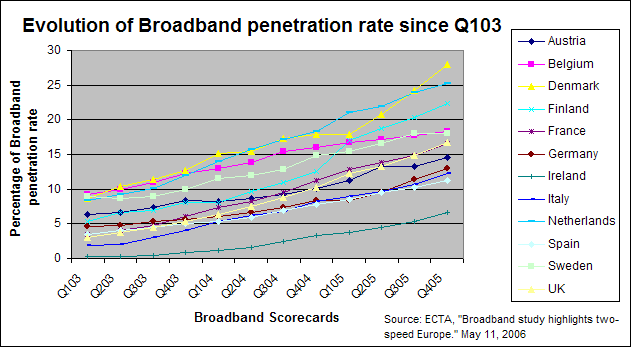President Bush’s goal of universal broadband access for all Americans by 2007 appears to be overly optimistic, according to a Government Accountability Office (GAO) report. The GAO study found that only 28% of Americans had broadband in 2005.
Between 42% to 48% of online Americans (active and less active) subscribe to a broadband service, according to surveys by Pew Internet and the GAO. Among active Internet users, US broadband penetration broke 70% for the first time in April 2006. In Europe, slow adoption among new member states has created a two-tier European Union, according to an ECTA survey. While more Americans are going online, Internet usage varies significantly across age groups with nearly three times as many younger Americans online as older Americans.
Bush Broadband Goal in Doubt: GAO
President Bush’s goal of “universal, affordable” broadband access for all Americans by 2007 is a stretch, according to a recent report by the GAO. Delivered to Congress as part of the Internet Tax Nondiscrimination Act of 2004, the report examines the factors that affect the deployment of broadband services. The GAO found that only 28 percent of Americans had broadband service (about 30 million American households) in 2005. The GAO found room for improvement in the FCC zip-code level broadband data, stating that it may not provide a “highly accurate depiction of local deployment of broadband infrastructure for residential service, especially in rural areas.”
While the GAO found progress in broadband deployment in the US, there are gaps in local and rural markets that are difficult to assess because of the way the FCC gathers its data. The GAO questioned the FCC numbers which showed that 99 percent of American live in the 95 percent of ZIP codes that have at least one broadband provider. “The FCC collects data based on where subscribers are served, not where providers have deployed broadband infrastructure,” the GAO report stated.
Using a survey of American households from Knowledge Networks/SRI’s The Home Technology Monitor Spring 2005 Ownership and Trend Report, the GAO found that 30 percent of surveyed households subscribed to dial-up connections while about 41 percent did not access the Internet from their home (see Figure 1).
Status of Household Computer Ownership and Internet Connection (US)
Figure 1: Status of Household Computer Ownership and Internet Connection (US)
Source: GAO Telecommunications Report: May 2006 (GAO-06-426)
Among online households, 50.4% subscribe to dial-up service while 47.6% subscribe to broadband (see Figure 2). Cable subscribers comprise 23.9% and DSL subscribers is at 24.4%, with only 1.3% subscribing to satellite service. Satellite access has about a 1/2 second latency which makes it inappropriate for VoIP or online gaming. Note that these figures have a margin of error of 7 percent, so the difference between DSL and cable is not statistically significant.
Household Online Connection Type (US)
Figure 2: Household Online Connection Type (US)
Source: GAO Telecommunications Report: May 2006 (GAO-06-426)
The GAO found several factors that influence the decision of households to adopt broadband. Households with higher incomes (the top 25%) were 39 percentage points more likely to adopt broadband than lower-income households. Those with a college-educated head of household were 12 percentage points more likely to buy broadband than households headed by someone without a college degree. Price remains a barrier to widespread broadband adoption, but surprisingly the imposition of a tax was a weakly significant factor.
Only 17% of rural households subscribe to broadband. However, when the lack of availability in rural areas is taken into account as well as demographic characteristics, rural households no longer appear to be less likely than their urban counterparts to subscribe to broadband. Younger Americans are more likely to subscribe to broadband than Americans aged 50 years or older (41% versus 23%).
Home Connectivity in the US
US broadband penetration grew to 70.44% in April 2006. Narrowband users connecting at 56Kbps or less now comprise less than 30% of active Internet users (29.56%), down 1.05 percentage points from 30.61% in March (see Figure 3).
Web Connection Speed Trends – Home Users (US)
Figure 3: Web Connection Speed Trends – Home Users (US)
Source: Nielsen//NetRatings
Broadband Growth Trends in the US
In April 2006, broadband penetration in US homes rose 1.05 percentage points to 70.44% up from 69.39% in March. This increase of 1.05 points is near the average increase in broadband of 1.1 points per month over the last six months (see Figure 4). If US broadband growth follows the pattern of other countries, the rate of penetration growth should decrease after reaching 70%.
Broadband Adoption Growth Trend – Home Users (US)
Figure 4: Broadband Adoption Growth Trend – Home Users (US)
Extrapolated from Nielsen//NetRatings data
Work Connectivity
Most Americans in the US enjoy high-speed connections to the Internet at their work. Most of them use a high-speed line such as a T1 connection, and share bandwidth between computers connected to an Ethernet network. The speed of each connection decreases as more employees hook up to the LAN. As of April 2006, 89.67% of US workers use broadband, up 0.54 percentage points from the 89.13% share in March. At work 10.33% connect at 56Kbps or less (see Figure 5).
Web Connection Speed Trends – Work Users (US)
Figure 5: Web Connection Speed Trends – Work Users (US)
Source: Nielsen//NetRatings
Broadband study highlights two-speed Europe
New member states are falling behind in broadband adoption creating a two-speed Europe, according to the latest ECTA Broadband Scorecard. ECTA’s quarterly report, which tracks broadband competition and take-up across the EU, found in January 2006 that broadband penetration was only 2.4% in Slovakia and 2.6% in Poland while Denmark had 28%, Netherlands 25.5%, and Finland had 22.4% broadband takeup. Unlike the US, where cable has higher penetration than DSL (56% versus 44% respectively according to Leichtman Research), European DSL grew to 82% this quarter, while cable fell to 16% of end-user retail connections. Satellite and wireless remain at just 2.3% of total connections.
European Broadband Trends
Figure 6: European Broadband Trends
Source: ECTA, used with permission
US Internet Penetration at 73%
The percentage of Americans who say they use the Internet has increased from 66% in January 2005 to 73% (147 million adults), according to Pew Internet. The percentage of Americans who have broadband connections at home grew from 29% (about 59 million) in January 2005 to 42% (about 84 million). Note that this broadband penetration figure is for all Americans, not active Internet users that Website Optimization measures.
Further Reading
- Broadband Deployment Is Extensive throughout the United States, but It Is Difficult to Assess the Extent of Deployment Gaps in Rural Areas (PDF)
- This report analyzes the factors that affect broadband deployment in the US. The report concludes that while broadband rollout has been rapid, “not all places and people have experienced the full benefits.” Determining exactly where broadband infrastructure has not been deployed is difficult because the FCC does not collect data on the geographic extent of providers’ service, only on subscriber statistics. “Without accurate, reliable data to aid in analysis of the existing deployment gaps, it will be difficult to develop policy responses toward gaps in broadband availability.” J. Z. Hecker, April 26, 2006 (GAO-06-426 Telecommunications, Washington, D.C.).
- Broadband study highlights two-speed Europe
- New member states are falling behind in broadband adoption creating a two-speed Europe, according to the latest ECTA Broadband Scorecard. ECTA found that in January 2006 broadband take-up was just 2.4% in Slovakia and 2.6% in Poland compared with 13.3% in Estonia and 12.8% in Malta – the highest performing of the new member states. Broadband penetration reached 28% in Denmark, followed by Netherlands 25.3% and Finland 22.4%. However, takeup remained at or below 13% in Germany, Italy and Spain, and was only 6.7% in Ireland and 1.5% in Greece. European Competitive Telecommunications Association (ECTA), May 11, 2006.
- Internet Penetration and Impact – April 2006
- Pew Internet found in April 6, 2006 that 73% of American adults say they use the Internet. Internet users note big improvements in their ability to shop, pursue hobbies and interest, do their jobs, and obtain health care information. Although Internet penetration has reached an all-time high, Internet use varies significantly across age groups. 88% of 18-29 year-olds go online, while 32% of those age 65 and over say they go online. M. Madden, April 26, 2006, PEW Internet.
- Nielsen//NetRatings
- Provided the US broadband penetration data for active Internet users for the Bandwidth Report.
- Over 3 Million Add Broadband in the First Quarter of 2006
- Using data from the FCC LRG found that the twenty largest cable and DSL providers in the US – representing about 94% of the market – acquired a record 3.06 million net additional subscribers in the first quarter of 2006. The top broadband providers now account for nearly 46 million high-speed Internet subscribers – with cable having nearly 25.8 million broadband subscribers, and DSL having about 20.2 million subscribers. Cable accounts for 56% of these broadband connections, while DSL accounts for 44%. Leichtman Research, May 15, 2006.
*Note that Nielsen//NetRatings NetSpeed report determines the connection speeds of the Digital Media Universe, which combines Web traffic, Internet applications and proprietary channels.
The Bandwidth Report is featured monthly on URLwire – news of useful and unique web content since 1994.

